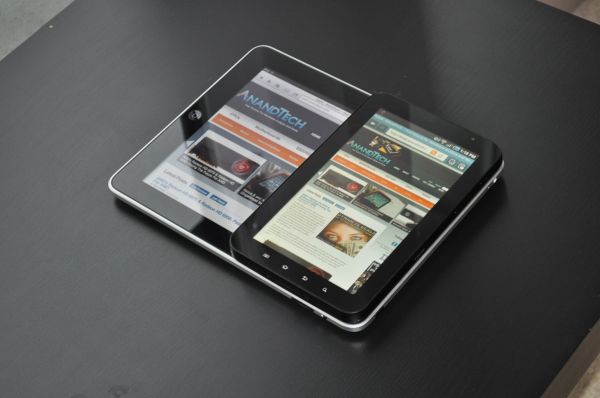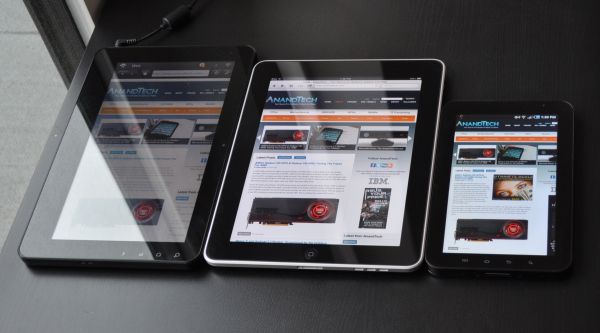Samsung Galaxy Tab - The AnandTech Review
by Vivek Gowri on December 23, 2010 9:48 AM ESTSamsung Galaxy Tab - Size Really Does Matter
The Galaxy Tab is almost exactly half the size of the iPad.
So the Galaxy Tab, as one of the first 7” tablets to release, brings up a new concern in the tablet space - how much does screen size change things? This is the first real 7” tablet I’ve played with for any length of time, but my first reaction when I pulled the Galaxy Tab out of the box was “dang, this thing is a lot smaller than I expected”. It’s literally half the size of the 9.7” iPad, dimensionally. It’s interesting to see two supposedly competitive devices have such different form factors, completely at odds with how the notebook market works.
The sizing thing is going to be a big deal for tablets going forward, and I think eventually we’ll see the market split into two or three segments based on size. It looks like some companies are already choosing one camp or the other; Apple appears staunchly in the 10” camp after Steve Jobs ripped on the entire 7” form factor, RIM is going 7” for its PlayBook, Dell started with 5” and are adding 7” and 9” models, HP took the middle road with its 8.9” slate, Samsung is adding a 10” Galaxy Tab early next year. So we’re going to be seeing tons of both 7” and 10” form factors on the market.
So why choose one form factor over the other? They’ll likely have similar internal hardware and the same WSVGA resolution on differently sized screens, so it won’t be on specs, and based on the current device pricing, I don’t expect that to be terribly different either. So, really, it comes down to whichever suits your use cases better.
Three tablets, three screen sizes. Pick your form factor wisely.
Honestly, here’s what I found: it’s more comfortable to use the 7” tablet in portrait mode, whereas it’s easier to use the 10”ers in landscape. This is true for both the 4:3 iPad or any of the 16:9 10” widescreen tablets. Part of it is in the keyboard - the 7” portrait keyboard is just comfortable enough to use with two thumbs, whereas in landscape its a bit too wide. The 10” has the opposite problem - too wide for two thumbs and too narrow for normal typing in portrait mode, but just about perfect with two handed typing in landscape. The difference is that with the 7” tablet, you can use it like a large smartphone, whereas the 10” tablets are more suited for use on a desk or table. The iPad and other 10” tablets are better as standalone netbook replacements, while the 7” Galaxy Tab almost feel like a device that’s meant to be carried in addition to a notebook.












97 Comments
View All Comments
tipoo - Thursday, December 23, 2010 - link
No problem.SimKill - Thursday, December 23, 2010 - link
This is a minor pet peeve but when you( you != Specific author, you == general) write your reviews I think there was one more where you'd written '[Product] - The Anandtech review' instead of '[X] review' like before.I'm coming to Anandtech, it would be fairly obvious to me that the reviews on this site would be AnandTech reviews and wouldn't be rip offs from other websites.
Oh, and good job.
tipoo - Thursday, December 23, 2010 - link
I love how you used !=. Do I detect a CS student/graduate?SimKill - Thursday, December 23, 2010 - link
Nah, mech grad here with boatloads of programming. I find != the most unambiguous way to 'I don't mean X when I say Y'.tipoo - Thursday, December 23, 2010 - link
Ah, I see. From what I've seen people who haven't done any programming use =/= to denote "does not equal", whereas people who have programed like us use !=.TheStu - Thursday, December 23, 2010 - link
I would say that the reason for saying [Product - The Anandtech Review] instead of just calling it [Product Review] is that Anandtech reviews tend to includ more technical information than others, there is still subjectivity in the writing, but what I take away from Anandtech's reviews is a better objective view of the product.So, although it is self serving, and a bit narcissistic to label it as [Product - The Anandtech Review], it does serve the purpose of making it clear what you are getting.
synaesthetic - Thursday, December 23, 2010 - link
I find it helpful because I read most of my tech blows in an RSS feed reader, and can't always immediately tell which blog posted the article!SimKill - Sunday, December 26, 2010 - link
This is a fair point. But I generally group my RSS by websites. So if I click on Anandtech I can see AT reviews and so on and so forth.SimKill - Sunday, December 26, 2010 - link
We know what we get from them which is exactly why we come here time and again. I found this to be a little immature for such an awesome set of people.And why not let the review speak for itself instead.
Don't get me wrong, there's a reason why I wait for AT reviews before deciding on anything major but I felt that as a group of highly professional writers I believe that there should be no place for self-serving and narcissism. But then again as the subject title indicates clearly, it's a minor peeve.
I still love AT reviews.
ATOmega - Thursday, December 23, 2010 - link
I have two major complaints over how manufacturers are approaching android tablets:First, it's very difficult if not impossible to get one not as part of a carrier plan. So currently Apple has zero competition for their iPads without 3G/4G. As much as some people will see this as an outdated market, here in Canada lots of people are avoiding our major carriers because they're a bunch of greedy a$$holes. There's very little point in having their data plans on tablets because you're still stuck rationing out MBs...Kind of takes the fun out of it.
Second, they're way overpriced. If as a result of the price being designed to encourage data plans, or if the manufacturers actually think they're worth that...The SOCs are dirt cheap as advertised by the people who make them and as part of the Android promise. The additional hardware used to make up the systems aren't nearly enough to reach $700 either. At the very least, we should be seeing sub $400 prices for non 3G/4G models.
I want Android tablets on the shelfs of local computer stores (big box or wholesale alike) and available without data plans.
I'd love to see Anandtech take on these details in future reviews. But I'm glad they're looking at Android the way they are already. Good show.